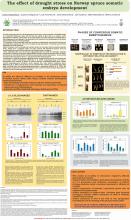Somatic embryogenesis is a developmental process where a plant somatic cell dedifferentiate to a totipotent embryonic stem cell that has the ability to give rise to an embryo under appropriate conditions. Desiccation is the final phase of normal embryonic development in most angiosperms and appears to be important in the transition from embryogeny to the ability to germinate and form normal seedlings. The objective of the presented study was to follow morphological and selected biochemical characteristics induced by various air humidity during desiccation of Norway spruce (Picea abies Karst.) somatic embryos. Abiotic stresses, such as drought and osmotic stress can increase reactive oxidative species levels, which have a negative impact on plant survival. We described abscisic acid and malondialdehyde content to follow the level of drought stress in embryos. Since chitinases (EC 3.2.1.14) and β-1,3-glucanases (EC 3.2.1.39) are hydrolytic enzymes expressed as a defense mechanism against different biotic and abiotic stresses (He et al. 2018), we focused on monitoring of their activities during somatic embryo desiccation. Concurrently we observed the expression of two b – glucanase and two chitinase genes. Autophagy is a catabolic pathway degrading cellular components to recycle macromolecules and ensure cellular homeostasis (Klionsky et al. 2016). Autophagy plays role both in development and reaction of plants to various stresses. Autophagy-related genes (ATGs) control autophagosome formation, which requires four main protein complexes (Avin- Wittenberg et al. 2018). Among them are two ubiquitin-like systems conjugating Atg12 with Atg5, and Atg8 with lipid phosphatidylethanolamine, respectively (Minina et al. 2018). We followed the expression of selected ATG genes in the course of somatic embryo desiccation to confirm the role of autophagy in this process.
Typ publikace
Datum vydání

